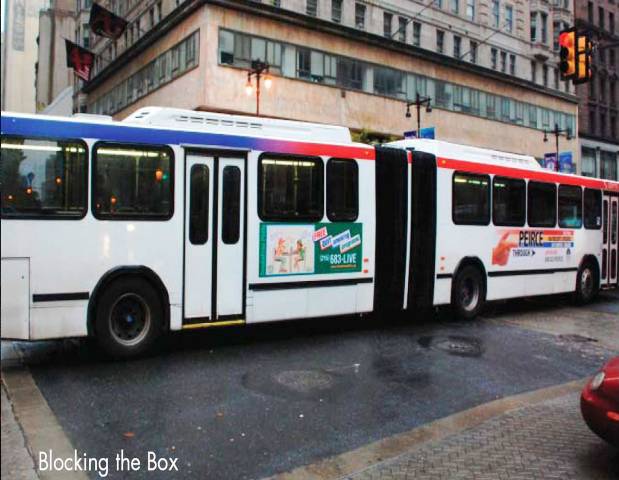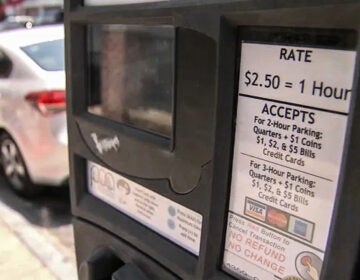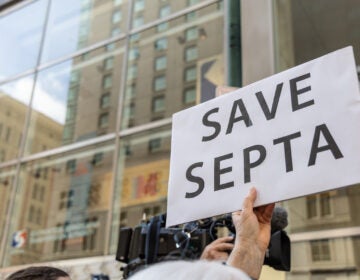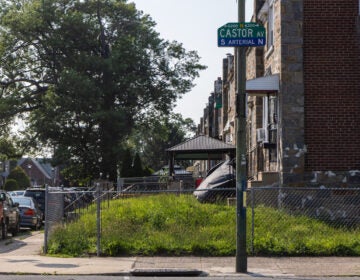Center City District weighs in on congestion

March 5
By Natalie Pompilio
For PlanPhilly
The good news: Center City is booming, with more businesses, residences and restaurants than ever before. The growth shows no sign of stopping, with new condos under construction, more retail moving in, and an expansion of the Convention Center that will mean even more visitors.
The bad news: Traffic is booming, too. A recent study by the Center City District showed that walking along certain stretches only took slightly longer than driving them, a plethora of delivery vans were consistently blocking traffic and misbehaving pedestrians were only enhancing roadway problems.
“Congestion is a result of success that we’re pleased to have,” said CCD President Paul R. Levy. “We think this is a good problem to have, but it’s a problem that needs to be addressed.”
The CCD released its study and a list of short-, mid- and long-term solutions this week, recommending city officials do everything from repaint lane markers to completely change traffic patterns on major thoroughfares like Market Street and JFK Boulevard.
Now, Levy said, is a good time to look at the traffic problems: Mayor Michael Nutter recently appointed Rina Cutler as deputy mayor of transportation, meaning there will be an official office to coordinate between the city, parking agencies, public transportation outlets, police and private companies, Gov. Ed Rendell last summer signed a transportation bill giving predictable, rising funds to the SEPTA and other such agencies.
“We think that, while we have a challenge here, things are aligned well at state and city levels,” Levy said.
The traffic study focused on the area between Broad and 23rd Streets, Chestnut and Walnut Streets. The number one cause of traffic snafus: Delivery trucks. On four occasions, CCD staff counted numerous delivery vehicles in this designated area at 10 a.m. and 2 p.m. Almost 50 were counted on Walnut Street with 63 tallied on Chestnut. Some trucks were double-parked, blocking traffic lanes. Some drivers used public space to unload, sometimes unloading into the street and causing more traffic slowdowns. The Philadelphia Parking Authority issues about $25,000 worth of tickets to these trucks monthly, but many companies incorporate this into the cost of doing business, Levy said.
Since such deliveries are essential, perhaps lesser-traveled Sansom Street could be used for deliveries during business hours or current parking lanes could be converted to “Delivery Only” areas. The city could charge a fee to the companies who use such areas, Levy said.
New construction and routine maintenance of streets and utilities were the other primary causes of congestion. Blocking the box, double parking and right-turning cars that are blocked by pedestrians and end up blocking vehicles behind them were found to be contributing factors.
More traffic police and enforcement officers would go a long way towards easing these problems, Levy said. Penalizing people is not necessarily the answer: Many drivers continue to block intersections and Levy suggested rewarding those who don’t. In New York, he said, that’s just what officials did when they started their “Don’t Block the Box” campaign.
Other suggestions from the report include restriping crosswalks, travel and bike lanes, removing some corner parking spaces to create turn lanes, and encouraging bike use by adding parking racks and dedicated bike lanes.
The report also urges officials to look at other cities for lessons: London charges a fee to drivers who traverse central city during rush hour. In Copenhagen, city planners removed parking spaces and added more public spaces and bike lanes.
Below are a proposed series of short-, mid- and long-term solutions to managing traffic congestion here.
Short-term solutions are low-cost actions that can be undertaken within the next 12 months and produce an immediate and visible impact on traffic congestion in Center City. They are:
• Buy cans of white paint In the absence of pavement markings, moving vehicles often straddle two lanes and stop in pedestrian crossing zones. The white lines denoting travel lanes and crosswalks throughout Center City should be repainted as soon as possible this spring and should be routinely scheduled for re-striping. As streets are resurfaced, different pavement types to permanently mark crosswalks and bike lanes should also be considered.
• Day lighting intersection: Cars waiting to turn at intersections are often blocked by the volume of pedestrians crossing the street. Their inability to turn backs up traffic behind them, preventing other cars from moving through the intersection. Two to three parking spaces could be removed throughout the study area on Chestnut and Walnut streets at numerous intersections where there is left-turn movement.
• Leading pedestrian intervals: This signal system creates a time period for pedestrians to safely cross while parallel traffic still has a red light, eliminating the danger that turning vehicles present to pedestrians in intersections. In Center City, the Streets Department has already installed such a system at 16th and Market and 20th and Market streets. This can be quickly expanded throughout Center City.
• Valet parking: The Nutter administration should undertake a comprehensive review of all existing valet parking licenses and review enforcement policies. Valet operations provide an important service, but some operators abuse the privilege of using public parking spaces for private business purposes.
• Penn Square: Immediate action is needed to re-evaluate all authorized on-street parking around City Hall and enforce parking regulations.
Mid-term actions can be taken over the next six to 12 months, but are more costly than the short-term solutions. They are:
• Safer pedestrian crossings: Pedestrian countdown timers that signal how much time is left to safely and legally cross can be installed at all major Center City intersections.
• Alternative locations for loading zones: Delivery trucks are essential to the competitiveness of downtown businesses. But all delivery trucks should be prohibited from parking on Chestnut and Walnut streets between 8 a.m. and 7 p.m. Instead, a new set of dedicated, delivery-truck-only loading zones should be designated on smaller and less-traveled streets. Parking meters at those locations could be removed and replaced by dedicated delivery spaces, paid for by the delivery companies. Permit fees and parking violation revenues from cars illegally parked in delivery-only spaces could be dedicated to pay in part for the restoration of traffic police in Center City.
• Uniformed officials at intersections: Traffic police should be restored to direct traffic at key Center City intersections during morning and evening rush hours and at lunchtime. In between, they should be rotated among problematic intersections. Fines for moving violations issued at downtown intersections could also be dedicated to pay for the traffic officers.
• Don’t block the box: With the restoration of traffic police, existing rules prohibiting cars from entering intersections should be vigorously enforced and frequently blocked intersections should be clearly striped.
• Dedicated bike lanes: Several east/west and north/south streets in Center City could be designated as bicycle-priority streets with dedicated bike lanes adjacent to the curb and separated from the car-parking lane with flexible bollards or plastic cones.
• Bike boxes: At intersections in the study area where a left turn is possible from Chestnut and Walnut streets, the stop bar for vehicles should be set back 10 feet from the crosswalk to create a “bike box,” allowing cyclists to safely switch lanes in front of stopped traffic and turn left.
• Dedicated bicycle parking spaces: One parking space could be removed on alternate blocks in Center City to create a bike-parking zone in the cartway. Eight bikes can fit into a parking space that previously accommodated only one car.
• Bike parking in private garages: The City, Center City District and Philadelphia Parking Association could collaborate on a plan in which private parking operators would create indoor bicycle parking spaces. Parking fees paid by bicyclists, with a potential subsidy from federal transportation enhancement funds, could help fund and promote the program. Liability issues however, need to be carefully reviewed and addressed.
Long-term solutions require more time and money. Several can be implemented on a demonstration basis; others should be considered only after other alternatives are tried. They are:
• Neckdown removal: The pavement bulb-outs constructed along Chestnut Street in the late 1990s should be removed to facilitate left turns and improve traffic flow.
• Better branding and marketing of buses and subways: SEPTA’s core objectives in Center City should be to encourage transit use both for commuting into the downtown and for travel within Center City. SEPTA, PATCO, CCD, PennDOT and the Delaware Valley Regional Planning Commission are already taking steps to make transit more visible, including a totally new graphic system for the 123 downtown entrances to the underground system. In addition, SEPTA should undertake to sell tokens and passes at multiple, highly visible locations throughout Center City. SEPTA should also explore replacing a portion of its Route 21 and 42 buses with smaller, high-frequency vehicles on a shorter route between Penn’s Landing and 38th Street to better connect Center City and University City. Small roadway changes on the Spring Garden Bridge would enable SEPTA’s Route 38 bus to link Center City with the Philadelphia Museum of Art and other attractions on the Benjamin Franklin Parkway.
• Real-time transit information: Philadelphia should install technology to communicate real-time transit information on several Center City routes on a demonstration basis.
• Bus-only lanes: SEPTA and the City should evaluate strict enforcement of bus-only lanes that already exist of Chestnut, Walnut and Market streets. There are, however, pros and cons to this approach, so rigorous use of bus-only lanes should wait until other recommendations to improve traffic flow have been tested.
• Multi-space meter parking: Multi-space meter parking, currently being tested on 2nd Street between Lombard and South streets, can accommodate 10-to-15% more vehicles and should be considered throughout Center City. Multi-space meters would also allow the City to experiment with variable parking rates on some blocks.
• Advanced parking systems: This type of wayfinding system relays current information about available off-street parking to drivers, alleviating the cruising and queuing that occurs as drivers search for available parking downtown.
• Four-way pedestrian crossing: With all signals red for vehicles, four-way crossings allow pedestrians to cross intersections east-west/north-south or on the diagonal, increasing pedestrian safety and crossing times. This system could be tested at an intersection such as 15th and Market streets to facilitate crossings to City Hall.
• Bus signal priority: This technology minimizes transit delays by automatically extending green signals and shortening red signals when a bus approaches. Given its expense, however, it should be considered only after other alternatives are tried.
• Extend two-way traffic on West Market Street and JFK Boulevard: In its April 2007 report, Planning for Growth, CCD proposed making both streets two-way from City Hall to 20th Street to improve access to the office district, reduce congestion and improve circulation.
WHYY is your source for fact-based, in-depth journalism and information. As a nonprofit organization, we rely on financial support from readers like you. Please give today.






